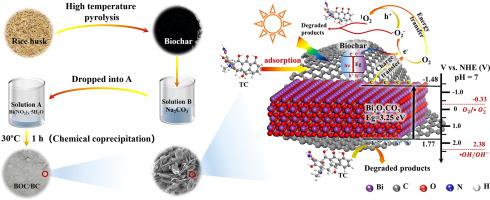Chemical Engineering Journal ( IF 13.3 ) Pub Date : 2022-12-29 , DOI: 10.1016/j.cej.2022.141228 Yidan Luo , Aofeng Zheng , Junda Li , Yu Han , Mingshan Xue , Longshuai Zhang , Zuozhu Yin , Chan Xie , Zhi Chen , Li Ji , Zhen Hong , Xianchuan Xie

|
Adsorption and photodegradation are two widely studied wastewater treatment technologies. In this work, we have firstly prepared the bismuth oxycarbonate (Bi2O2CO3) and biochar nanocomposites for synergistic adsorption-photodegradation of tetracycline (TC). It was found that Bi2O2CO3 and biochar composites exhibited stronger adsorption capacity and photocatalytic activity compared to Bi2O2CO3. Among them, Bi2O2CO3/2.5 wt% biochar possessed the highest adsorption capacity for TC (173.0 mg/L) and the best combined removal rate of TC (84.7 %) in 60 min by adsorption and photodegradation, which were 1.9 times and 1.5 times that of Bi2O2CO3, respectively. The biochar in the composite increased the specific surface area, promoted the adsorption of TC, facilitated charge transfer capability, thereby enhanced the photocatalytic activity of composites. The effects of experimental parameters (temperature, co-existing ions, and initial pH) on TC degradation were examined. Electron spin resonance (ESR) and trapping experiments of free radical confirmed that 1O2, •O2− and h+ were the main species in photocatalytic degradation. The potential degradation pathways were proposed based on liquid chromatograph mass spectrometer (LC-MS) test of the intermediates of TC degradation. It is hoped that this work not only represents the significantly importance of biochar in photocatalytic wastewater treatment, but also promotes further interests in design synergistic adsorption-photodegradation materials.
中文翻译:

碳酸氧铋/生物炭纳米复合材料对四环素的综合吸附和光降解
吸附和光降解是两种广泛研究的废水处理技术。在这项工作中,我们首先制备了碳酸氧铋 (Bi 2 O 2 CO 3 ) 和生物炭纳米复合材料,用于四环素 (TC) 的协同吸附-光降解。结果发现,与Bi 2 O 2 CO 3 相比,Bi 2 O 2 CO 3和生物炭复合材料表现出更强的吸附能力和光催化活性。其中,Bi 2 O 2 CO 3/2.5 wt% 生物炭对 TC 的吸附容量最高(173.0 mg/L),吸附和光降解 60 min 对 TC 的综合去除率最好(84.7 %),分别是 Bi 2 O的 1.9 倍和 1.5 倍2 CO 3,分别。复合材料中的生物炭增加了比表面积,促进了TC的吸附,促进了电荷转移能力,从而增强了复合材料的光催化活性。研究了实验参数(温度、共存离子和初始 pH)对 TC 降解的影响。电子自旋共振(ESR)和自由基捕获实验证实1 O 2 , •O 2 −和 h +是光催化降解的主要物种。基于TC降解中间体的液相色谱质谱仪(LC-MS)测试提出了潜在的降解途径。希望这项工作不仅代表了生物炭在光催化废水处理中的重要意义,而且还促进了对设计协同吸附-光降解材料的进一步兴趣。






























 京公网安备 11010802027423号
京公网安备 11010802027423号